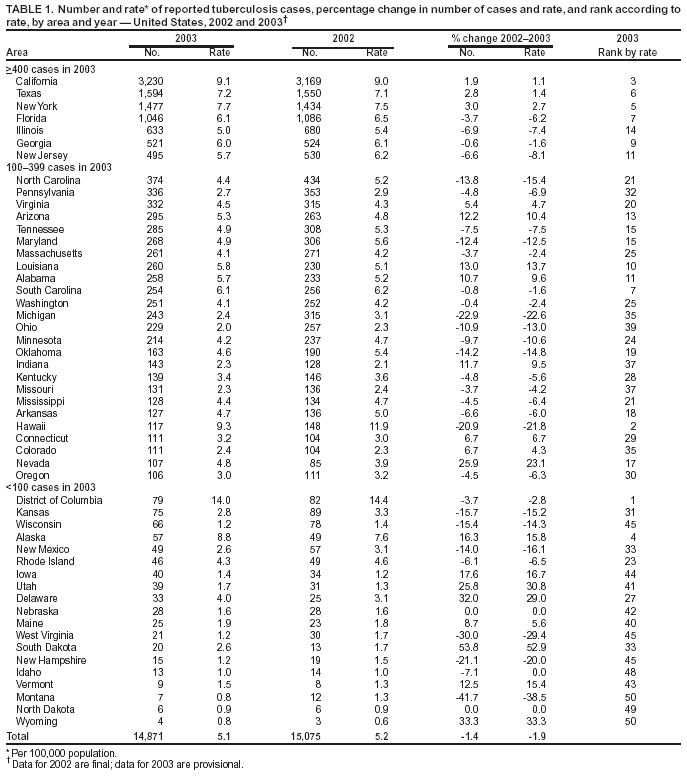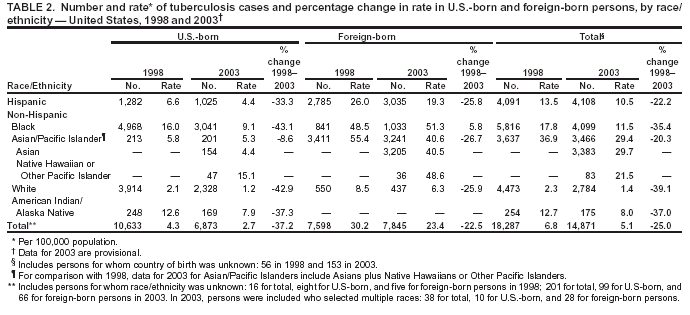 |
|
|
|
|
|
|
| ||||||||||
|
|
|
|
|
|
|
||||
| ||||||||||
|
|
|
|
|
Persons using assistive technology might not be able to fully access information in this file. For assistance, please send e-mail to: mmwrq@cdc.gov. Type 508 Accommodation and the title of the report in the subject line of e-mail. Trends in Tuberculosis --- United States, 1998--2003Please note: An erratum has been published for this article. To view the erratum, please click here.During 2003, a total of 14,871 tuberculosis (TB) cases (5.1 cases per 100,000 population) were reported in the United States, representing a 1.4% decrease in cases and a 1.9% decline in the rate from 2002. This decline is the smallest since 1992, when TB incidence peaked after a 7-year resurgence. In addition, the rate remains higher than the national interim goal of 3.5 cases per 100,000 population that was set for 2000 (1). This report summarizes data from the national TB surveillance system for 2003 and describes trends during a 5-year period, with comparison to 1998 and 2002. Despite a decline in TB nationwide, rates have increased in certain states, and elevated TB rates continue to be reported in certain populations (e.g., foreign-born persons and racial/ethnic minorities). Targeted interventions for these at-risk populations, continued collaborative efforts toward the global fight against TB, and adequate local resources are essential to eliminating TB in the United States. The 50 states and the District of Columbia (DC) report cases to the national TB surveillance system at CDC by using a standard case definition and report form (2). Data were analyzed for cases reported during 1998--2003 by using reports updated as of February 24, 2004. A U.S.-born person was defined as someone born in the United States or its associated jurisdictions, or someone born in a foreign country but having at least one U.S.-born parent; other persons were classified as foreign-born. U.S. Census population estimates were used to calculate national and state TB rates for 2003 (3), and the Current Population Survey (March 2002) was used to extrapolate the total U.S.-born and foreign-born populations for 2003 (4). The 2002 U.S. Census population estimates were used to extrapolate and calculate race/ethnicity TB rates for 2003 (5,6). U.S. Census Bureau national population estimates were used to calculate the U.S.-born, foreign-born, and racial/ethnic populations for 1998 (7,8). During 2003, a total of 12 states and DC reported rates above the national average (5.1 cases per 100,000 population), and 24 states met the definition for low incidence (<3.5 cases per 100,000 population) (Table 1). Among the 19 states that reported increases in cases during 2002--2003, California, New York, and Texas accounted for 42.4% of the 2003 national case total. Among those areas reporting <100 cases in 2003, only Alaska and DC had rates higher than the national average (Table 1). In 2003, foreign-born persons accounted for 53.3% (7,845 cases) of the national case total, and 25 states reported >50% of their cases among foreign-born persons. The foreign-born prevalence represents an increase from 1998, when foreign-born persons accounted for 41.7% (7,598) of TB cases nationwide, and 13 states reported >50% of their cases among foreign-born persons. The 2003 TB rate among foreign-born persons (23.4 cases per 100,000 population) was 8.7 times greater than that among U.S.-born persons (2.7 cases per 100,000 population), representing an increased rate ratio from 1998 (7.0) and from 2002 (8.0). For the top three reporting states (California, New York, and Texas), the 1998--2003 decrease in cases among U.S.-born persons (32.2%; from 3,179 to 2,155) was four times greater than the decrease among foreign-born persons (7.6%; from 4,420 to 4,086). In 2003, the five birth countries of foreign-born patients with TB reported most commonly were Mexico (25.6%), the Philippines (11.6%), Vietnam (8.4%), India (7.7%), and China (4.8%). TB patients from certain countries were concentrated in certain states. For example, New York reported 56.1% of the national total born in Ecuador, Minnesota reported 55.2% of patients born in Somalia, California reported 52.3% of patients born in the Philippines, and Florida reported 49.4% of patients born in Haiti. Among 6,429 foreign-born TB patients aged >15 years, 3,410 (53.0%) had resided in the United States >5 years before TB diagnosis, 1,778 (27.7%) resided in the United States 1--4 years, and 1,241 (19.3%) resided in the United States <1 year. Disparities in TB rates persist among racial/ethnic minority populations. In 2003, two modifications were made to the TB report form: 1) multiple race entries were allowed, with 0.3% selecting more than one race, and 2) the previous category of Asian/Pacific Islander was divided into "Asian" and "Native Hawaiian or Other Pacific Islander." During 2003, the highest rates were reported among racial/ethnic minority populations (Table 2). The non-Hispanic black population had the largest number of TB cases (3,041 cases, 45.0%). During 2003, drug resistance among initial isolates of Mycobacterium tuberculosis in persons with no previous TB episodes was more common in foreign-born patients than in U.S.-born patients. With 82.3% of data on drug-susceptibility testing complete, multidrug resistance (i.e., resistance to at least isoniazid and rifampin) among foreign-born persons was 1.2% (U.S.-born: 0.6%). During the preceding 5 years, the proportion of multidrug-resistant TB has been stable (1998: foreign-born, 1.3% and U.S.-born, 0.7%). In 2000, a total of 80.8% of reported TB patients completed therapy in <1 year, and 92.2% completed therapy overall. Reported by: Div of Tuberculosis Elimination, National Center for HIV, STD, and TB Prevention, CDC. Editorial Note:During 1993--2002, the average year-to-year decrease in TB rate was 6.8%. However, 2003 had the smallest annual decrease (1.9%), raising concern about a possible slowing of the progress against TB. During the preceding decade, certain key challenges to TB control were identified, including 1) an increasing proportion of TB among persons born in countries with high rates of TB, 2) disparities among racial/ethnic minority populations, and 3) unique TB epidemiologic trends found in localized areas throughout the United States. Birthplace data were first collected by the national TB surveillance system in 1986, when 21.8% of TB cases occurred among foreign-born persons. Since then, the proportion has increased steadily, with the highest proportion being reported in 2003, a trend enhanced by the decrease in TB cases among U.S.-born persons. Foreign-born TB patients also are more likely to have multidrug-resistant TB than U.S.-born patients, and the cost of caring for patients with multidrug-resistant TB is high (9). CDC is collaborating with partners (e.g., U.S. Agency for International Development, International Union Against TB and Lung Disease, Royal Netherlands TB Association, and World Health Organization) to assist countries with high burdens of TB. CDC collaborations have focused on operational research and programmatic evaluation to address problems such as TB/human immunodeficiency virus coinfection and drug resistance in approximately 20 countries. CDC also is contributing to improvements in TB screening among immigrant and refugee visa applicants, both overseas and in the United States, through the development of innovative tracking mechanisms, new diagnostic tools, and updated medical screening guidelines. A CDC-sponsored assessment of TB prevention among foreign-born persons is under way in 22 locations in the United States and Canada. The elimination of disparities among racial/ethnic minority populations is a priority for TB control. CDC continues to work with the Advisory Council for the Elimination of TB and public health partners to identify contributing factors and develop strategies to eliminate existing disparities. Epidemiologic profiles for individual states often are varied and distinct. Changing immigration patterns, proximity to the U.S.-Mexico border, drug resistance, and outbreaks can affect TB incidence. Tailored TB-control strategies and continued monitoring of TB epidemiology are needed to identify emerging populations at high risk. The data described in this report reflect key challenges to TB control and the need for sustained efforts to eliminate TB in the United States. Targeted interventions for populations at high risk, active involvement in the global effort against TB, and adequate local resources are essential to eliminate TB in the United States (10). Acknowledgments The findings in this report are based on surveillance data contributed by TB control officials in state and local health departments. References
Table 1  Return to top. Table 2  Return to top.
Disclaimer All MMWR HTML versions of articles are electronic conversions from ASCII text into HTML. This conversion may have resulted in character translation or format errors in the HTML version. Users should not rely on this HTML document, but are referred to the electronic PDF version and/or the original MMWR paper copy for the official text, figures, and tables. An original paper copy of this issue can be obtained from the Superintendent of Documents, U.S. Government Printing Office (GPO), Washington, DC 20402-9371; telephone: (202) 512-1800. Contact GPO for current prices. **Questions or messages regarding errors in formatting should be addressed to mmwrq@cdc.gov.Page converted: 3/18/2004 |
|||||||||
This page last reviewed 3/18/2004
|